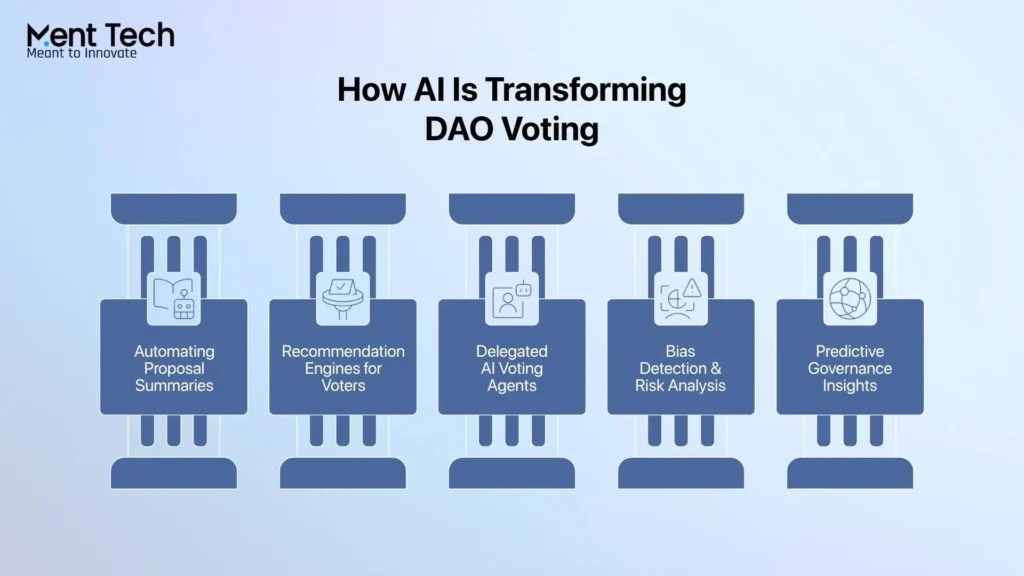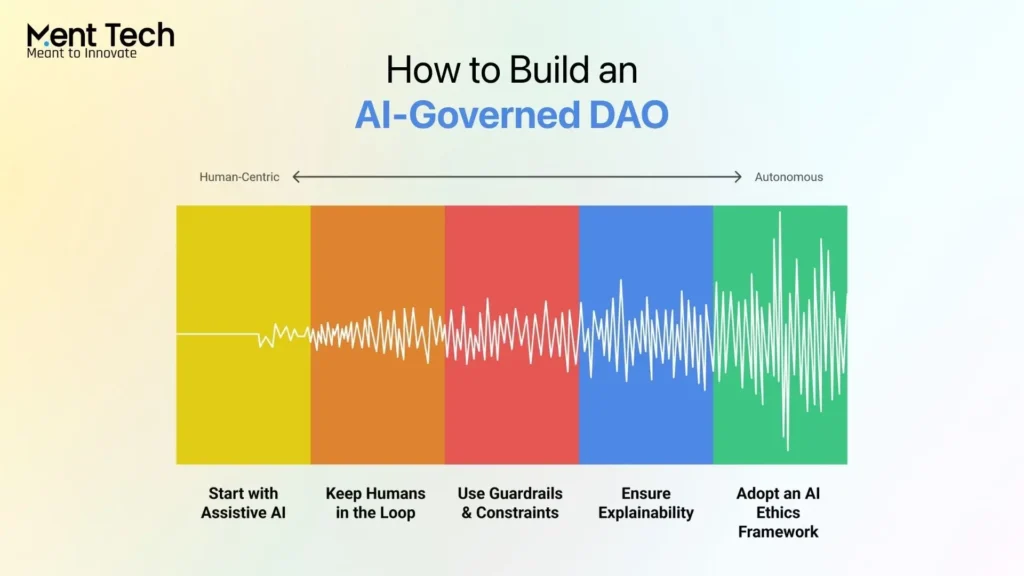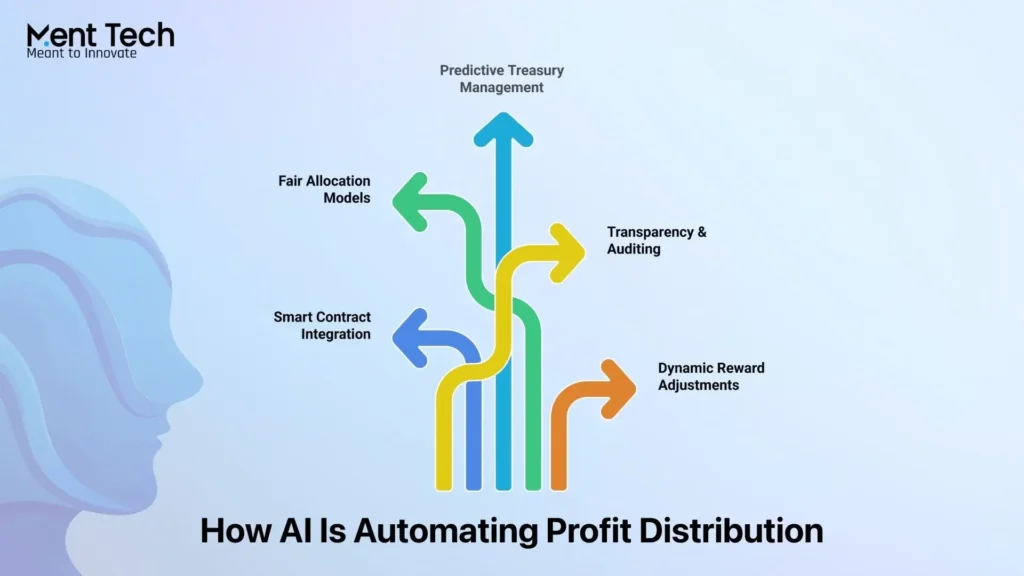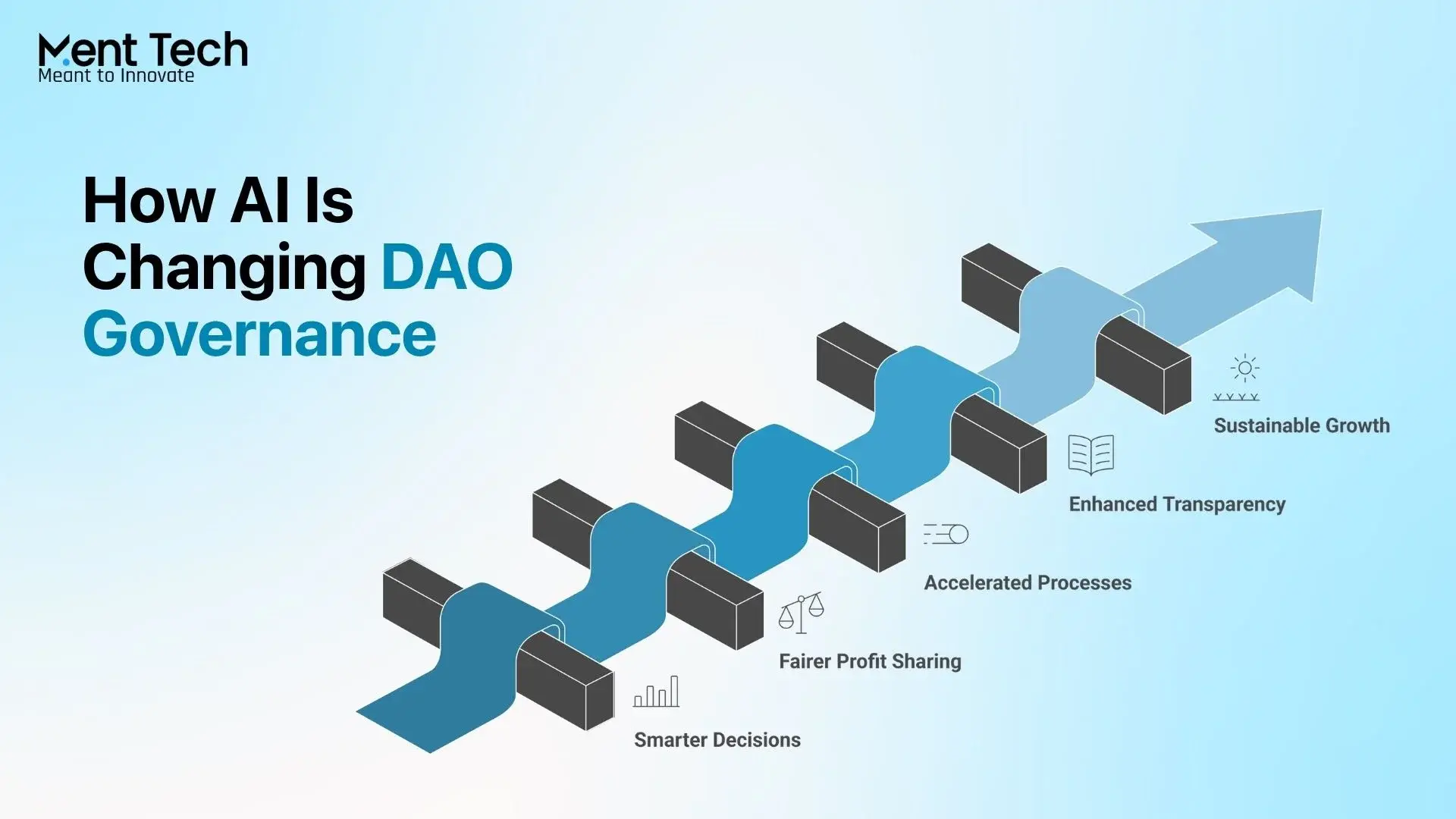Decentralized Autonomous Organizations (DAOs) were built to decentralize decision-making but low participation, voter fatigue, and information overload limit their potential. Most DAO votes are influenced by a few large holders, leading to governance centralization. AI can rebalance this equation by making decision-making faster, more informed, and more inclusive.
AI integration in DAO governance is emerging as a key solution to enhance voting systems and automate profit distribution for greater transparency and efficiency. The current landscape shows significant challenges that AI DAO Voting and Profit Sharing solutions can address. Right now, voter participation averages only 17% across most DAOs, with top DAOs reaching 22-28% for major proposals. Projects like the Near Foundation are experimenting with AI “digital twins” to vote on behalf of users, trained on their preferences and past activity. There has been a 40% increase in the use of governance tools like Snapshot and Tally in 2025.
These numbers highlight the urgent need for AI-driven DAO voting mechanisms that can bridge the gap between DAO ideals and reality.
Why DAO Voting Needs an Upgrade?
DAO voting today is largely manual, time-consuming, and biased toward whales. Members struggle to read every proposal or understand technical implications. The current DAO voting mechanisms face several critical challenges:
- Low Participation: Token-based voting can be inefficient and discouraging for small holders
- Information Overload: Complex proposals with lengthy documentation create barriers to informed voting
- Whale Dominance: Large token holders disproportionately influence outcomes
- Voter Fatigue: Constant voting requests lead to decreased engagement over time
This creates a “governance gap” , the mismatch between DAO ideals of collective intelligence and DAO reality of low engagement. Traditional DAO voting platforms have not adequately addressed these fundamental issues.
The integration of AI can close this gap by automating research, summarization, and rational decision-making processes. How DAO voting works with AI represents a fundamental shift toward more inclusive and efficient governance.
How AI Can Transform DAO Voting?

AI-driven DAO voting mechanisms offer multiple pathways to enhance governance participation and quality:
1. Automating Proposal Summaries
AI can read and summarize governance proposals in plain language for members, helping them make informed decisions. Large Language Models process complex technical documents and extract key points, voting implications, and potential risks.
2. Recommendation Engines for Voters
AI can suggest how to vote based on each member’s preferences, past behavior, or the DAO’s mission statement. These systems analyze historical voting patterns and align recommendations with individual values and organizational goals.
3. Delegated AI Voting Agents
Members can assign “AI delegates” that vote on their behalf based on programmed values, creating a more active, responsive governance system. This approach to AI DAO Voting ensures continuous participation even when human token holders are unavailable.
4. Bias Detection and Risk Analysis
AI can flag biased, risky, or conflicting proposals before voting occurs, reducing manipulation. Advanced algorithms identify anomalies in voting patterns and detect potential Sybil attacks or collusive behavior.
5. Predictive Governance Insights
AI can forecast the potential outcomes of proposals before voting begins. By analyzing historical data, community sentiment, and market signals, AI helps DAOs anticipate the long-term impact of each decision enabling more strategic and forward-looking governance.

Why AI-Driven Voting Builds Stronger DAOs?
AI-driven DAO voting creates multiple benefits that strengthen organizational governance:
- Increases Participation: People engage more when voting becomes easier and faster
- Enhances Decision Quality: AI can analyze thousands of data points including financials, community sentiment, and token flows to inform collective decisions
- Reduces Manipulation: Advanced systems detect bot-driven or malicious voting patterns early
- Keeps DAOs Agile: Faster execution means quicker responses to opportunities or threats in DeFi, NFTs, or community initiatives
Organizations like Aragon are exploring AI-powered governance recommendations, demonstrating real-world applications of these concepts. Their DAO Governance Engine incorporates machine learning to optimize decision-making processes.
The implementation of AI in DAO governance systems requires sophisticated Generative AI Development and Adaptive AI Development approaches to ensure systems learn and improve over time.
How Profit Sharing Works in Today’s DAOs?
DAOs generate revenue through multiple channels that need effective distribution systems. Traditional DAO profit sharing involves manual governance votes or periodic distributions that face significant challenges:
- Protocol Fees and Treasury Income: Revenue comes from DeFi development protocol interactions, yield farming, staking rewards, and community investments that require distribution
- Token Buybacks and Dividends: Common models include using revenue to purchase and burn tokens or distributing profits directly to token holders based on their stake
- Inconsistent Manual Payouts: Distribution processes depend on individuals to execute payments, leading to delays, unpredictability, and reduced member confidence
- Calculation and Distribution Errors: Manual mistakes in determining and sending rewards create disputes and undermine trust in the system
- Governance Capture Risks: Large stakeholders can vote to favor their own interests over the broader community, creating unfair distribution outcomes
- Lack of Real-Time Transparency: Members remain uncertain about treasury health and distribution timing, making DAO voting mechanisms slow and inefficient
How to Design an AI-Governed DAO Safely?

Implementing AI-driven DAO voting mechanisms requires careful consideration of safety and governance principles. Follow these steps to build a secure and effective system:
Step 1: Start with Assistive AI
Begin by using AI for analytics and voting recommendations before giving it direct voting power. Deploy the system in advisory mode where it suggests decisions but humans make final choices. This gradual approach allows communities to build trust and understanding of AI capabilities. Monitor how accurately the AI predictions align with community preferences and adjust the models based on feedback.
Step 2: Keep Humans in the Loop
Final votes or overrides should still be validated by members. Design the system so that AI handles routine decisions automatically but escalates important or controversial matters to human governance. Human oversight ensures decisions align with community values and can be corrected when necessary. Establish clear thresholds for when AI can act independently versus when it needs human approval.
Step 3: Use Guardrails and Constraints
Limit AI control through smart contract constraints and treasury caps. Set maximum amounts the AI can allocate in a single transaction or time period. Create spending categories where AI has different authority levels. These technical safeguards prevent potential misuse or errors from causing significant harm. Program emergency stop mechanisms that allow the community to pause AI operations if problems emerge.
Step 4: Ensure Explainability
Every AI vote or payout decision must include a clear, human-readable reason. The system should log its decision-making process, showing which factors it considered and how they weighted in the final choice. Transparency in AI decision-making builds trust and enables community oversight. Members should be able to review past decisions and understand the logic behind each one.
Step 5: Adopt an AI Ethics Framework
Define principles for fairness, bias control, and accountability before deploying the system. Create written guidelines that specify how the AI should handle edge cases and ethical dilemmas. This framework guides AI Development and ensures systems serve community interests. Include regular audits to check for bias in AI decisions and processes to update the system when problems are found.
The “Human-AI hybrid governance model” represents the current best practice for organizations experimenting with AI-driven DAO voting, balancing automation benefits with human oversight. This approach leverages AI efficiency while preserving democratic control and human judgment.
How AI Can Automate Profit Distribution?

AI-powered DAO profit sharing systems offer sophisticated automation capabilities:
1. Smart Contract Integration
AI can connect real-time financial data to distribution contracts, triggering automated payments when certain thresholds are met. This integration ensures consistent and timely profit distribution without manual intervention.
2. Fair Allocation Models
Machine learning analyzes contribution data, activity levels, and performance metrics to allocate profits proportionally. These systems consider multiple factors including governance participation, community contributions, and value creation.
3. Predictive Treasury Management
AI can forecast DAO revenue, manage reserves, and optimize reward pools for sustainability. Advanced AI Development enables predictive modeling that balances current distributions with long-term organizational health.
4. Transparency and Auditing
Every AI-triggered transaction can be logged on-chain for full traceability. This creates an immutable record of all profit-sharing decisions and distributions.
5. Dynamic Reward Adjustments
AI can adjust profit distribution models in real time based on changing market conditions or community performance. This ensures rewards remain fair, adaptive, and aligned with the DAO’s evolving economic landscape.
Why AI-Driven Profit Sharing Strengthens DAO Economies?
Automated profit distribution through AI DAO Voting and Profit Sharing systems creates multiple economic benefits that transform how decentralized organizations operate. It encourages continuous contribution by rewarding value creation automatically, making the system meritocratic rather than political. Distribution decisions become data-driven rather than emotional, removing human bias and eliminating accusations of favoritism.
As organizations grow from hundreds to thousands of members, the DAO profit sharing system scales effortlessly without human bottlenecks. This creates more efficient capital allocation and stronger economic incentives for community participation while building trust through transparent, consistent, and auditable processes that every member can verify.
Conclusion
The next generation of DAOs will combine AI precision with human judgment. We can imagine “governance agents” that represent voting intent 24/7, or DAOs that auto-distribute revenue like autonomous cooperatives.
As AI matures, we will see DAOs evolve into self-managing digital organizations where human creativity meets machine efficiency. The integration of AI-driven DAO voting and automated profit sharing represents a fundamental shift in organizational governance.The development of these systems requires ongoing innovation in Adaptive AI Development and careful consideration of human values and democratic principles.
The question is not if AI will join DAO governance it is how responsibly we design that partnership. The future of decentralized organizations depends on our ability to harness AI capabilities while preserving human agency and democratic values.
Frequently Asked Questions
No, AI should not completely replace human voters. The best approach combines AI efficiency with human judgment in what experts call a hybrid governance model. AI handles routine decisions, data analysis, and proposal summaries while humans make final calls on important matters.
DAOs need clear rollback mechanisms and human override capabilities built into their systems. Smart contracts should include emergency stop functions that allow the community to pause AI operations and reverse decisions when necessary. The key is setting appropriate guardrails limiting how much the AI can do independently and requiring human approval for major decisions.
Implementation costs vary widely based on system complexity. Basic AI tools for proposal summarization might cost a few thousand dollars in development, while sophisticated AI DAO Voting systems with automated treasury management could require hundreds of thousands in initial development. Ongoing costs include AI model training, data processing, and system maintenance.
No, well-designed systems make participation easier for non-technical members. The AI should translate complex proposals into plain language and provide clear voting recommendations with explanations. Members just need to understand their values and preferences – the AI handles the technical analysis. Good DAO voting platforms focus on user experience, making the interface as simple as voting in any online poll.
Preventing AI bias requires multiple safeguards. Use diverse training data that represents all community segments rather than just the loudest voices. Conduct regular audits where independent reviewers check for biased patterns in AI decisions. Make the AI’s decision-making process transparent so members can identify and challenge unfair outcomes. Include bias detection algorithms that flag suspicious patterns.
The legal status varies by jurisdiction and remains unclear in many places. Using AI for analysis and recommendations generally faces fewer legal issues than giving AI direct control over funds. Automated profit distribution through DAO profit sharing systems may trigger securities regulations in some countries.


